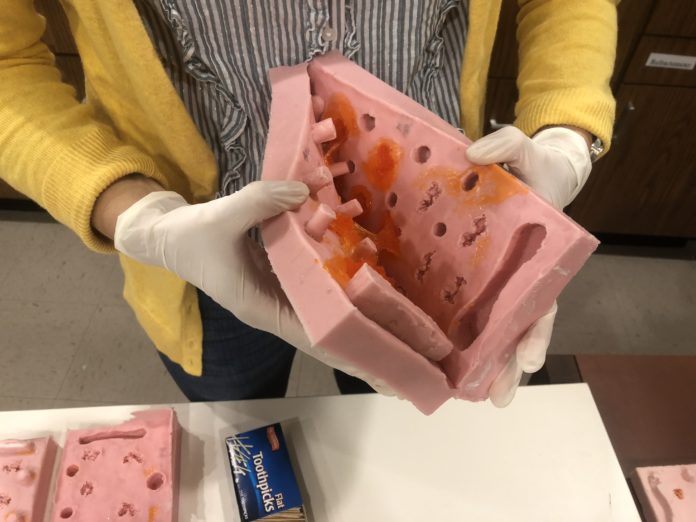
Rewon Shimray | Staff Writer
Blind students are the most underrepresented students in science, according to Dr. Bryan Shaw, assistant professor of chemistry and biochemistry. Shaw and a group of student researchers are developing a gummy candy to help visually impaired students experience science in a new way.
“Part of the problem is a lot of education is based on seeing stuff. But you see with your mind, not your eyes, so [visually impaired students] shouldn’t be totally out of the game,” Shaw said.
Shaw’s research group makes gummies that replicate protein structures so visually impaired students can picture the shape they feel with their mouth. Oral senses are more sensitive than tactile (touch) senses. Shaw originally created a 3-D printed model on a braille-labeled stick, which has now been replaced by the gummy development.
Shaw said the idea came from realizing that the “bulbar typology” of a blackberry or raspberry is similar to that of a protein structure. He thought about the ability of the tongue to detect fine hairs on the surface of berries, and how that could be used to make observations about a protein model. Shaw also uses the gummy-form to encode flavor information, engaging the gustatory or taste senses.
“Nobody has thought about using the mouth to help kids see objects or to use taste or anything like that,” Shaw said. “We want to be able to show visually impaired children the same stuff sighted people see.”
Shaw’s primary hope is to provide equal opportunities for science exploration. Shaw has two sons, one of which is Noah, who lost who lost an eye to retinoblastoma — an eye cancer that affects children under five years old.
Katelyn Baumer, graduate student and one of Shaw’s research assistants, said Noah is interested in the sciences and has been receptive to the gummies. Baumer said protein structures are often what initiates people’s interest in biochemistry.
“When I was in high school, I saw a structure of a protein — a beautiful structure. I didn’t know what it was, but it was cool and I wanted to learn about it,” Shaw said. “That’s all we really want to do at this point, is just show the kids science.”
The study of biochemistry is founded on protein structures, Baumer said. Proteins each have a unique structure that determines their function. Protein form is often considered in the study of diseases such as sickle cell anemia, which is caused by protein misfolding.
The nine protein gummies have been tested on Noah periodically over the course of several months. Shaw said his son is the perfect testing candidate until his work is approved by the institutional board.
In the hour-long tests, Baumer introduces a new protein, detailing its function and structure. She then gives Noah one gummy of each type of protein and two of the type she just described. Baumer said Noah has a 70 to 80 percent accuracy rate. Noah is also able to recall formerly learned protein forms months later, according to Baumer, which shows that the gummies function as more than “a quick memory game.”
“It’s really cool that we can teach a 10 year-old about protein structures, because that’s not something we learn in school, even through high school,” Baumer said.
Baumer said her vision for their project long-term is to distribute the resources to schools. She said they will likely ship the silicone models used to make the gummies in order for schools to make them, because Shaw’s research group is only able to produce three to nine batches a week.
A team of undergraduate research students spend three to four hours a week making and modifying the gummies in a food-safe laboratory in the Mary Gibbs Jones Family Consumer Science Building. One of the students’ jobs is to find a balance between the powder and gelatin to find the ideal mixture for taste, form-holding and color. The gummies are made from a combination of Jell-O box flavoring and unflavored gelatin. The mixture is then squirted into FDA-approved silicone molds, refrigerated for a week then carefully removed from the molds. Gummies are put into small braille-labeled plastic containers.
The silicone model for production was developed by May 2018 Baylor graduate Katie Carleton who now attends optometry school at University of Houston. She joined Shaw’s research group when she read about his 3D printed protein structures in a Lariat article. When Shaw was transitioning into an edible form, Carleton began to think about ways to create gummy molds. She said she found the idea for silicone molds after finding a YouTube video of someone cast-molding a lightsaber. Carleton said Shaw’s research group was a way to use both her interest in eyes and problem-solving skills.
Two student researchers, Argyle junior Lilly Carter and Lake Jackson senior Cheyenne Eisenmann were both not aware of the needs of visually impaired students before joining Shaw’s research group. Eisenmann said it is a topic she thinks about more now.
“The whole idea of being pre-med is because we want to help people,” Carter said. “This is an indirect way we can start helping people now, before we’re out of school. We’re probably not going to be able to meet the students that this has a potential to affect, but it’s making a difference for them to be able to learn about the same things that we’re able to learn that are giving us the passion to go to school.”





